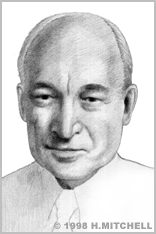Arnold Beckman
Over 60 years ago, Arnold O. Beckman invented the world’s first pH meter, initiating a long and distinguished career as a businessman, philanthropist, and inventor of scientific instruments.
Beckman was born on April 10, 1900 in the farm town of Cullom, Illinois. He discovered his love of chemistry upon reading a book that he had found in the attic of his house, Steel’s "Fourteen Weeks in Science" (published in 1861). By the age of ten, with the help of his father, he had built himself a chemistry lab in a shed in his backyard.
Beckman went on to earn a BS in Chemical Engineering (1922) and MS in Physical Chemistry (1923) from the University of Illinois, funding his education by playing the piano during silent movies. After working for the Bell Telephone Labs in New York for two years, Beckman continued his education at the California Institute of Technology, where he earned a PhD in Photochemistry (1928) and stayed on thereafter to teach.
In 1935, a former classmate who was working at a California citrus processing plant came to Beckman with a problem: how to measure the acidity levels of lemon juice. At that time, scientists could easily tell if a substance was acidic, but not how acidic it was. Beckman responded by inventing the “acidimeter.” This device not only solved his friend’s specific problem; it became the world’s first pH (acidity / alkalinity) meter and was the basis upon which, in 1935, Beckman founded Beckman Instruments, Inc. (now Beckman Coulter).
Until 1940, Beckman divided his time between teaching and developing new products. In that year, he invented what has been called the “Model T” of scientific instrumentation: the Beckman DU Spectrophotometer (1940). This device forever simplified and streamlined chemical analysis, by allowing researchers to perform a 99.9% accurate biological assessment of a substance within minutes, as opposed to the weeks required previously for results of only 25% accuracy.

Beckman’s original pH meter was the industry standard for measuring acidity and alkalinity until the invention of electrochemical pH meters. In time, Beckman’s spectrophotometer was superseded by new devices produced by his own company and others. Even so, thousands of the original model are still in use around the world today.
But Beckman has other inventions to his credit. In fact, the “acidimeter” had earned him his fourth patent. In 1940, Beckman also patented the “Helipot” (helical potentiometer), a “Variable Resistance Device” that functioned like a supersensitive radio volume control and found applications not only in scientific research devices but in control and computer systems and even home appliances. Beckman has earned a total of 14 patents and has overseen numerous additional inventions.
Beckman Instruments quickly developed into one of the world’s foremost producers of scientific instruments for use in science, medicine, industry, environment, and even space exploration. These include digital models of pH meters and photospectrometers, as well as centrifuges and many other apparatus used in scientific and medical research.
After his own success was secured, Beckman and his wife entered into a long and distinguished career of philanthropy, funding especially education and research in the life sciences. The Arnold and Mabel Beckman Foundation has donated over $300 million to support a number of science education programs for young people, as well as laboratories and institutes at nearly a dozen facilities around the country.
Arnold Beckman was Founder and Chairman Emeritus of Beckman Instruments and directed the Beckman Foundation until his death on May 18, 2004. Towards the end of his life, he had possibly won more major honors for scientific and philanthropic achievements than any living American, including both the National Medal of Technology and the National Medal of Science.
SUGGESTED LINKS:
A full biography of Arnold Beckman’s career: http://www.beckman-foundation.com/arnold-beckman


